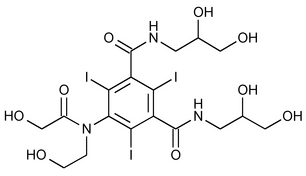Ioversol
(eye'' oh ver' sol).
1,3-Benzenedicarboxamide, N,N¢-bis(2,3-dihydroxypropyl)-5-[(hydroxyacetyl)(2-hydroxyethyl)amino]-2,4,6-triiodo-.
N,N¢-Bis(2,3-dihydroxypropyl)-5-N-(2-hydroxyethyl)glycolamido]-2,4,6-triiodoisophthalamide.
» Ioversol contains not less than 97.0 percent and not more than 101.0 percent of C18H24I3N3O9, calculated on the anhydrous basis.
Packaging and storage—
Preserve in well-closed containers. Store at 25 , excursions permitted between 15
, excursions permitted between 15 and 30
and 30 .
.
Identification—
B:
Heat about 500 mg in a crucible: violet vapors are evolved.
Water, Method I  921
921 :
not more than 5%.
:
not more than 5%.
Residue on ignition  281
281 :
not more than 0.1%.
:
not more than 0.1%.
Related compounds—
Mobile phase—
Prepare a degassed mixture of water and acetonitrile (99.5:0.5).
Standard solution—
Dissolve accurately weighed quantities of USP Ioversol Related Compound A RS and USP Ioversol Related Compound B RS in water to obtain a solution having known concentrations of about 1.0 µg per mL of USP Ioversol Related Compound A RS and 5.0 µg per mL of USP Ioversol Related Compound B RS.
Test solution—
Transfer about 100 mg of Ioversol, accurately weighed, to a 100-mL volumetric flask, dissolve in and dilute with water to volume, and mix.
Chromatographic system (see Chromatography  621
621 )—
The liquid chromatograph is equipped with a 254-nm detector and a 4.6-mm × 25-cm stainless steel column containing packing L7. The flow rate is about 1 mL per minute. The column temperature is maintained at 35 ± 0.5
)—
The liquid chromatograph is equipped with a 254-nm detector and a 4.6-mm × 25-cm stainless steel column containing packing L7. The flow rate is about 1 mL per minute. The column temperature is maintained at 35 ± 0.5 . The system is capable of operating at a column pressure of up to 3000 psi. Chromatograph the Standard solution, and record the peak responses as directed for Procedure: the resolution, R, between ioversol related compound A and ioversol related compound B is not less than 2.0; and the relative standard deviation for replicate injections is not more than 5%.
. The system is capable of operating at a column pressure of up to 3000 psi. Chromatograph the Standard solution, and record the peak responses as directed for Procedure: the resolution, R, between ioversol related compound A and ioversol related compound B is not less than 2.0; and the relative standard deviation for replicate injections is not more than 5%.
Procedure—
Separately inject equal volumes (about 50 µL) of the Standard solution and the Test solution into the chromatograph, record the chromatograms, and measure the peak responses. Calculate the percentage of each ioversol related compound in the portion of Ioversol taken by the formula:
100(C/W)(rU / rS)
in which C is the concentration, in mg per mL, of USP Ioversol Related Compound A RS or USP Ioversol Related Compound B RS in the Standard solution; W is the concentration, in mg per mL, of Ioversol in the Test solution; rU is the peak response obtained from the Test solution; and rS is the average peak response from the Standard solution. Not more than 0.10% of ioversol related compound A and not more than 0.50% of ioversol related compound B are found.
Iodine and iodide—
Dissolve 2.0 g of Ioversol in water in a 50-mL glass-stoppered cylinder, and dilute with water to 15 mL. To this solution add 5 mL each of diluted sulfuric acid and toluene. Shake vigorously, and allow the layers to separate: the toluene layer shows no red color. Add 1 mL of sodium nitrite solution (1 in 50), and shake: any red color in the toluene layer is not darker than that obtained from a mixture of 2 mL of potassium iodide solution (1 in 4000) and 13 mL of water, similarly treated (0.02% of iodide).
Heavy metals, Method I  231
231 :
0.002%.
:
0.002%.
Standard solution—
Into a 50-mL color-comparison tube, pipet 2 mL of Standard Lead Solution (20 µg of lead), and dilute with water to 10 mL.
Test solution—
Dissolve 1 g in 10 mL of water in a 50-mL color-comparison tube.
Procedure—
For each of the tubes containing the Standard solution and the Test solution, adjust with 1 N acetic acid or 6 N ammonium hydroxide to a pH of 3.0 to 4.0 using short-range pH indicator paper as external indicator, dilute with water to 40 mL, and mix. Add 1.2 mL of thioacetamide-glycerin base TS and 2 mL of pH 3.5 Acetate Buffer, allow to stand for 5 minutes, and view downward over a white surface: the color of the solution from the Test solution is not darker than that of the solution from the Standard solution, treated in the same manner. The limit is 20 µg per g.
Assay—
Transfer about 500 mg of Ioversol, accurately weighed, to a glass-stoppered 125-mL conical flask, add 12 mL of 5 N sodium hydroxide, 20 mL of water, and 1 g of powdered zinc, connect the flask to a reflux condenser, and reflux for 30 minutes. Cool the flask to room temperature, rinse the condenser with 20 mL of water, disconnect the flask from the condenser, and filter the mixture. Rinse the flask and filter thoroughly, adding the rinsings to the filtrate. Add 40 mL of 2 N sulfuric acid, and titrate immediately with 0.05 N silver nitrate VS, determining the endpoint potentiometrically, using a silver-silver chloride double junction reference electrode and a silver billet electrode. Each mL of 0.05 N silver nitrate is equivalent to 13.45 mg of C18H24I3N3O9.
Auxiliary Information—
Please check for your question in the FAQs before contacting USP.
| Topic/Question | Contact | Expert Committee |
|---|---|---|
| Monograph | Ravi Ravichandran, Ph.D.
Principal Scientific Liaison 1-301-816-8330 |
(SM42010) Monographs - Small Molecules 4 |
| Reference Standards | RS Technical Services 1-301-816-8129 rstech@usp.org |
USP35–NF30 Page 3546
Pharmacopeial Forum: Volume No. 29(6) Page 1910

